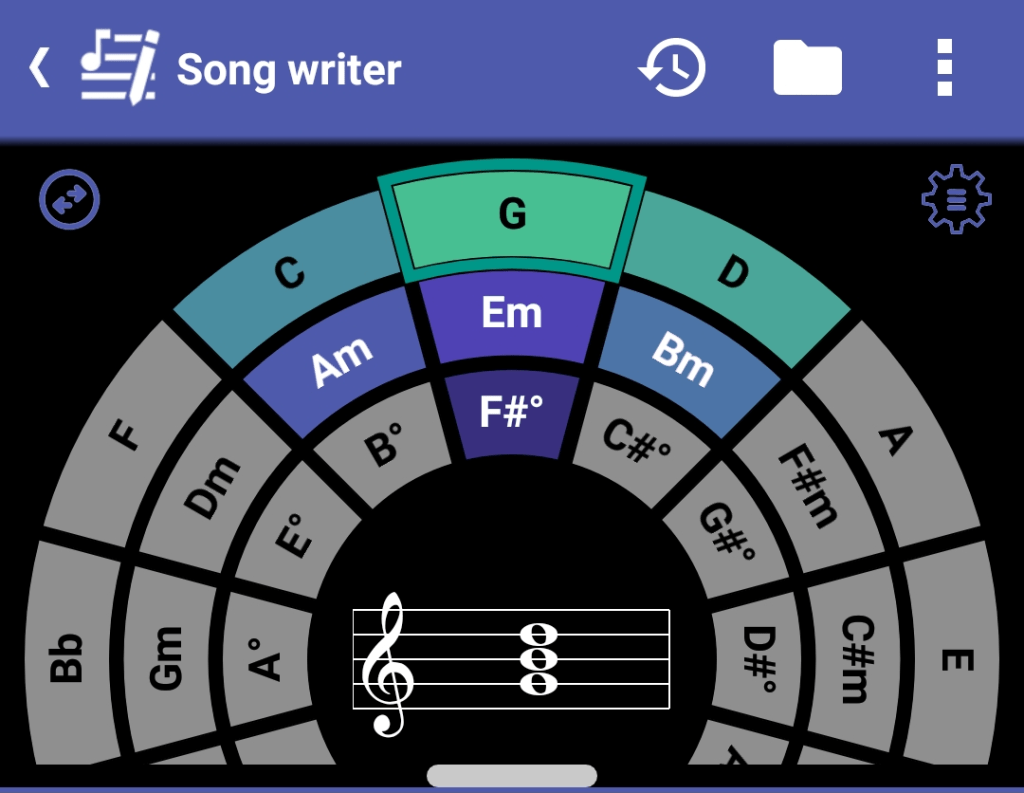Find the right chords

The top of the Song Writer contains the area that contains the chords for your song. Each chord can be clicked to select and listen to it. In the top left corner is a button for switching between multiple chord sources. These are either the circle of fifths, the scale-circle or the diatonic chords of the used scale. In the top right corner, there is a button for the settings of the respective chord source. Use them to change the key, the scale or the chord structure. You’ll get different chords with each change. The chord source area can be resized by dragging the handle at the bottom.
Circle of Fifths

smartChords Circle of Fifths is the default chord source. It is integrated seamlessly into the Song Writer. Use it to find the chords for your song and your chord progressions.
The Circle of Fifths is an essential tool for songwriting. It serves as a helpful reference and starting point for creating harmonically coherent and satisfying chord progressions. The chords in the Circle of Fifths often sound good together due to their harmonic relationships and the way they share common tones. The Circle of Fifths reflects the principles of functional harmony, where certain chords have specific functions within a key. Moving in fifths creates a sense of tonal gravity. The fifth interval is considered stable and consonant, which contributes to the pleasing sound of the chord progressions. This tonal gravity helps establish a strong sense of resolution and stability when moving from one chord to another.
Scale-Circle

Major and minor scales are often used in Western music. But the Circle of Fifths can be used for any diatonic scale, not just the major scale. While the Circle of Fifths is commonly associated with the major scale due to its widespread use in Western music, the underlying principles can be applied to other diatonic scales as well, such as the natural minor scale or modes of the major scale.
That’s what the Scale-Circle does. It applies the principles of the Circle of Fifths to other diatonic scales. Using chord progressions based on different diatonic scales has the potential to develop new and exciting music. By exploring different tonalities and modes, you can introduce new harmonic colors, moods, and flavors to your compositions.
When you step outside the familiar territory of the major scale and its traditional chord progressions, you open up opportunities for musical exploration and innovation. Different diatonic scales offer unique intervals, chord qualities, and melodic possibilities that can give your music a fresh and distinct character.
Using alternative diatonic scales can help create a sense of variety, surprise, and originality in your compositions. It can also evoke different emotional responses from listeners, as each scale has its own inherent mood and tonal characteristics.
By venturing beyond the conventional, you can infuse your music with creativity and uniqueness. It allows you to break away from predictable patterns and tap into new musical ideas, ultimately enriching your compositions and offering listeners a refreshing experience.
Diatonic chords

Diatonic chords have the potential to bring a breath of fresh air into music. While diatonic chords are derived from a particular diatonic scale, there are countless ways to arrange and combine them in chord progressions to create unique and interesting musical textures.
By exploring different chord progressions within a diatonic framework, you can discover fresh harmonic sequences and unexpected chord relationships. This experimentation can result in novel and captivating musical moments that deviate from more traditional or predictable progressions.
Additionally, diatonic chords can be used in unconventional ways, such as incorporating inversions, extensions, or substitutions, which can further add depth and complexity to your compositions. By exploring alternative voicings and chord variations, you can give your music a distinct character and evoke different emotions.
Moreover, diatonic chords can be combined with other non-diatonic elements, such as chromatic passing tones or borrowed chords from related keys, to create further harmonic interest and variety.
Overall, diatonic chords provide a solid foundation for composition while allowing ample room for innovation and creativity. By exploring different chord progressions, voicings, and harmonic techniques within the diatonic framework, you can infuse your music with a breath of fresh air, making it exciting, distinct, and engaging for both yourself and your listeners.
Btw, diatonic chords are chords that are derived from the notes of a scale. They are like a family of chords that share the same notes. Each note of the scale serves as a root note for a chord. For example, in the key of C major, there are seven different notes (C, D, E, F, G, A, B). It is possible to build a chord on each of these seven notes. These chords are called diatonic chords because they are all built using the notes of the C major scale (see also https://en.wikipedia.org/wiki/Diatonic_scale).
In contrast, chords that use notes outside of the diatonic scale are called chromatic chords.
Settings

